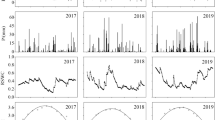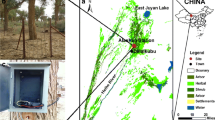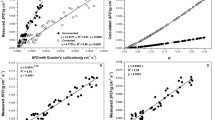Abstract
Key message
Vapor pressure deficit, soil water content, and daily maximum air temperature were the most important variables to affect sap flow.
Abstract
Tree transpiration has a vital role in maintaining water balance in forest ecosystems, but how environmental variables affect transpiration is not clear at different altitudes in the regions of the arid mountains of China. With significant changes in water regimes in arid areas due to climate change, a greater understanding of transpiration responses to environmental variables will determine ecosystem health and management. Therefore, using the heat ratio method, sap flow in Qinghai spruce (Picea crassifolia) at different microenvironment conditions was monitored over 2 years (2016 and 2017) in the Qilian Mountains. Environmental variables were measured synchronously with sap flow. The random forests model showed that vapor pressure deficit (VPD), soil water content (SWC), and daily maximum air temperature (Tmax) were the most important variables to affect sap flow across four sites and two years. These results differed within sites and years. The important variables were VPD and SWC in 2016 due to lower precipitation, and VPD and Tmax in 2017. Meanwhile, the most important variables were VPD in 2016 and Tmax in 2017 at the high-elevation site, while opposite at the low-elevation site. Nonlinear models showed that sap flow decreased when VPD > 0.7–1.0 kPa, and saturated when Tmax > 15–20 °C. Sap flow was more sensitive to SWC at low than at high elevation. We concluded that VPD, SWC, and Tmax controlled sap flow in Qinghai spruce at these sites. Precipitation played a key role in controlling sap flow in different years, and altitudes affected the responses of sap flow to environmental variables within years.






Similar content being viewed by others
References
Ayyoub A, Er-Raki S, Khabba S, Merlin O, Ezzahar J, Rodriguez JC, Chehbouni A (2017) A simple and alternative approach based on reference evapotranspiration and leaf area index for estimating tree transpiration in semi-arid regions. Agric Water Manag 188:61–68
Barrett DJ, Hatton TJ, Ash JE, Ball MC (1995) Evaluation of the heat pulse velocity technique for measurement of sap flow in rainforest and eucalypt forest species of south-eastern Australia. Plant Cell Environ 18(4):463–469
Belgiu M, Drăguţ L (2016) Random forest in remote sensing: a review of applications and future directions. ISPRS J Photogramm 114:24–31
Berry ZC, Looker N, Holwerda F, Gomez Aguilar LR, Ortiz Colin P, Gonzalez Martinez T, Asbjornsen H (2018) Why size matters: the interactive influences of tree diameter distribution and sap flow parameters on upscaled transpiration. Tree Physiol 38(2):263–275
Bond BJ, Jones JA, Moore G, Phillips N, Post D, McDonnell JJ (2002) The zone of vegetation influence on baseflow revealed by diel patterns of streamflow and vegetation water use in a headwater basin. Hydrol Process 16(8):1671–1677
Bovard BD, Curtis PS, Vogel CS, Su HB, Schmid HP (2005) Environmental controls on sap flow in a northern hardwood forest. Tree Physiol 25(1):31–38
Burgess SSO, Adams MA, Turner NC, Beverly CR, Ong CK, Khan AAH, Bleby TM (2001) An improved heat pulse method to measure low and reverse rates of sap flow in woody plants. Tree Physiol 21(9):589–598
Butz P, Raffelsbauer V, Graefe S, Peters T, Cueva E, Hölscher D and Bräuning A (2016) Tree responses to moisture fluctuations in a neotropical dry forest as potential climate change indicators. Ecol Indic 83: 559-571
Cammalleri C, Rallo G, Agnese C, Ciraolo G, Minacapilli M, Provenzano G (2013) Combined use of eddy covariance and sap flow techniques for partition of ET fluxes and water stress assessment in an irrigated olive orchard. Agric Water Manag 120:89–97
Campbell GS, Norman JM (1998) Introduction to environmental biophysics. Springer, Berlin, p 286
Chang X, Zhao W, Zhang Z, Su Y (2006) Sap flow and tree conductance of shelter-belt in arid region of China. Agric For Meteorol 138(1–4):132–141
Chang X, Zhao W, He Z (2014a) Radial pattern of sap flow and response to microclimate and soil moisture in Qinghai spruce (Picea crassifolia) in the upper Heihe River Basin of arid northwestern China. Agric For Meteorol 187:14–21
Chang X, Zhao W, Liu H, Wei X, Liu B, He Z (2014b) Qinghai spruce (Picea crassifolia) forest transpiration and canopy conductance in the upper Heihe River Basin of arid northwestern China. Agric For Meteorol 198–199:209–220
Chen D, Wang Y, Liu S, Wei X, Wang X (2014) Response of relative sap flow to meteorological factors under different soil moisture conditions in rainfed jujube (Ziziphus jujuba Mill.) plantations in semiarid Northwest China. Agric Water Manag 136:23–33
Chirino E, Bellot J, Sánchez JR (2011) Daily sap flow rate as an indicator of drought avoidance mechanisms in five Mediterranean perennial species in semi-arid southeastern Spain. Trees 25(4):593–606
Clausnitzer F, Köstner B, Schwärzel K, Bernhofer C (2011) Relationships between canopy transpiration, atmospheric conditions and soil water availability—analyses of long-term sap-flow measurements in an old Norway spruce forest at the Ore Mountains/Germany. Agric For Meteorol 151(8):1023–1034
Cutforth H, Wall K (2020) Water stress, sap flow and transpiration for medium and highly drought resistant poplars grown in the semiarid Canadian prairie. Can J Plant Sci 100(4):1–3
Du S, Wang Y, Kume T, Zhang J, Otsuki K, Yamanaka N, Liu G (2011) Sapflow characteristics and climatic responses in three forest species in the semiarid Loess Plateau region of China. Agric For Meteorol 151(1):1–10
Ford CR, Goranson CE, Mitchell RJ, Will RE, Teskey RO (2005) Modeling canopy transpiration using time series analysis: a case study illustrating the effect of soil moisture deficit on Pinus taeda. Agric For Meteorol 130(3–4):163–175
Gartner K, Nadezhdina N, Englisch M, Čermak J, Leitgeb E (2009) Sap flow of birch and Norway spruce during the European heat and drought in summer 2003. For Ecol Manag 258(5):590–599
Gazal RM, Scott RL, Goodrich DC, Williams DG (2006) Controls on transpiration in a semiarid riparian cottonwood forest. Agric For Meteorol 137(1–2):56–67
Granier A, Loustau D, Bréda N (2000) A generic model of forest canopy conductance dependent on climate, soil water availability and leaf area index. Ann For Sci 57(8):755–765
Grote R, Gessler A, Hommel R, Poschenrieder W, Priesack E (2016) Importance of tree height and social position for drought-related stress on tree growth and mortality. Trees 30(5):1467–1482
Hassler SK, Weiler M, Blume T (2018) Tree-, stand- and site-specific controls on landscape-scale patterns of transpiration. Hydrol Earth Syst Sci 22(1):13–30
Hayat M, Zha T, Jia X, Iqbal S, Qian D, Bourque C, Khan A, Tian Y, Bai Y, Liu P, Yang R (2020) A multiple-temporal scale analysis of biophysical control of sap flow in Salix psammophila growing in a semiarid shrubland ecosystem of northwest China. Agric For Meteorol 288–289:107985
IPCC (2013). In: Stocker TF et al (eds) Climate change 2013: the physical science basis. Cambridge Univ. Press, Cambridge
Juhász Á, Sepsi P, Nagy Z, Tőkei L, Hrotkó K (2013) Water consumption of sweet cherry trees estimated by sap flow measurement. Sci Hortic 164:41–49
Kool D, Agam N, Lazarovitch N, Heitman JL, Sauer TJ, Ben-Gal A (2014) A review of approaches for evapotranspiration partitioning. Agric For Meteorol 184:56–70
Kubota M, Tenhunen J, Zimmermann R, Schmidt M, Adiku S, Kakubari Y (2005) Influences of environmental factors on the radial profile of sap flux density in Fagus crenata growing at different elevations in the Naeba Mountains, Japan. Tree Physiol 25(5):545–556
Kumagai TO, Aoki S, Shimizu T, Otsuki K (2007) Sap flow estimates of stand transpiration at two slope positions in a Japanese cedar forest watershed. Tree Physiol 27(2):161–168
Lang P, Ahlborn J, Schäfer P, Wommelsdorf T, Jeschke M, Zhang X, Thomas FM (2016) Growth and water use of Populus euphratica trees and stands with different water supply along the Tarim River, NW China. For Ecol Manag 380:139–148
Leo B (2001) Random forests. Mach Learn 45(1):5–32
Leo M, Oberhuber W, Schuster R, Grams TEE, Matyssek R, Wieser G (2014) Evaluating the effect of plant water availability on inner alpine coniferous trees based on sap flow measurements. Eur J For Res 133(4):691–698
Li W, Si J, Yu T, Li X (2016) Response of Populus euphratica Oliv. sap flow to environmental variables for a desert riparian forest in the Heihe River Basin, Northwest China. J Arid Land 8(4):591–603
Li X, Gentine P, Lin C, Zhou S, Sun Z, Zheng Y, Zheng C (2019) A simple and objective method to partition evapotranspiration into transpiration and evaporation at eddy-covariance sites. Agric For Meteorol 265:171–182
Lin P, He Z, Du J, Chen L, Zhu X, Li J (2017) Recent changes in daily climate extremes in an arid mountain region, a case study in northwestern China’s Qilian Mountains. Sci Rep 7(1):2245
Liu X, Biondi F (2020) Transpiration drivers of high-elevation five-needle pines (Pinus longaeva and Pinus flexilis) in sky-island ecosystems of the North American Great Basin. Sci Total Environ 739:139861
Liu B, Ming X, Mark H, Ye Q (2005) Observed trends of precipitation amount, frequency, and intensity in China, 1960–2000. J Geophys Res 110(D8)
Liu X, Shao X, Zhao L, Qin D, Chen T, Ren J (2007) Dendroclimatic temperature record derived from tree-ring width and stable carbon isotope chronologies in the Middle Qilian Mountains, China. Arc Antarct Alp Res 39(4):651–657
Looker N, Martin J, Hoylman Z, Jencso K, Hu J (2018) Diurnal and seasonal coupling of conifer sap flow and vapour pressure deficit across topoclimatic gradients in a subalpine catchment. Ecohydrology 11(7):e1994
Ma C, Luo Y, Shao M, Li X, Sun L, Jia X (2017) Environmental controls on sap flow in black locust forest in Loess Plateau, China. Sci Rep 7(1):13160
Mapeto T, Louw J, Gush M, Pauw J (2018) Whole-tree sap flow responses to soil water and weather variables for Pinus radiata and three indigenous species in a southern afrotemperate forest region. South For 80(4): 329–339
Marshall DC (1958) Measurement of sap flow in conifers by heat transport. Plant Physiol 33(6):385–396
Meinzer FC, Bond BJ, Warren JM, Woodruff DR (2005) Does water transport scale universally with tree size? Funct Ecol 19(4):558–565
Mitchell PJ, Benyon RG, Lane PN (2012) Responses of evapotranspiration at different topographic positions and catchment water balance following a pronounced drought in a mixed species eucalypt forest, Australia. J Hydrol 440:62–74
Otieno D, Li Y, Ou Y, Cheng J, Liu S, Tang X, Tenhunen J (2014) Stand characteristics and water use at two elevations in a sub-tropical evergreen forest in southern China. Agric For Meteorol 194:155–166
Peng X, Fan J, Wang Q, Warrington D (2014) Discrepancy of sap flow in Salix matsudana grown under different soil textures in the water-wind erosion crisscross region on the Loess Plateau. Plant Soil 390(1–2):383–399
Poyatos R, Aguade D, Galiano L, Mencuccini M, Martinez-Vilalta J (2013) Drought-induced defoliation and long periods of near-zero gas exchange play a key role in accentuating metabolic decline of Scots pine. New Phytol 200(2):388–401
Rahmati O, Pourghasemi HR, Melesse AM (2016) Application of GIS-based data driven random forest and maximum entropy models for groundwater potential mapping: a case study at Mehran Region, Iran. CATENA 137:360–372
Rousseaux MC, Figuerola PI, Correa-Tedesco G, Searles PS (2009) Seasonal variations in sap flow and soil evaporation in an olive (Olea europaea L.) grove under two irrigation regimes in an arid region of Argentina. Agric Water Manag 96(6):1037–1044
Sánchez-Costa E, Poyatos R, Sabaté S (2015) Contrasting growth and water use strategies in four co-occurring Mediterranean tree species revealed by concurrent measurements of sap flow and stem diameter variations. Agric For Meteorol 207:24–37
Shalini O, Daniel H, Louis D, Daniel K (2020) Vapour pressure deficit and solar radiation are the major drivers of transpiration of balsam fir and black spruce tree species in humid boreal regions, even during a short-term drought. Agric For Meteorol 291:108063
Shen Q, Gao G, Fu B, Lü Y (2015) Sap flow and water use sources of shelter-belt trees in an arid inland river basin of Northwest China. Ecohydrology 8(8):1446–1458
Talsma CJ, Good SP, Jimenez C, Martens B, Fisher JB, Miralles DG, Purdy AJ (2018) Partitioning of evapotranspiration in remote sensing-based models. Agric For Meteorol 260:131–143
Thomas FM, Foetzki A, Gries D, Bruelheide H, Li X, Zeng F, Zhang X (2008) Regulation of the water status in three co-occurring phreatophytes at the southern fringe of the Taklamakan Desert. J Plant Ecol 1(4):227–235
Tian FX, Zhao CY, Feng ZD (2011) Simulating evapotranspiration of Qinghai spruce (Picea crassifolia) forest in the Qilian Mountains, northwestern China. J Arid Environ 75(7):648–655
Tian Q, He Z, Xiao S, Du J, Peng X, Chen L, Lin P, Zhu X, Ding A (2017) Growing season stem water status assessment of Qinghai spruce through the sap flow and stem radial variations in the Qilian Mountains of China. Forests 9(1):2
Tie Q, Hu H, Tian F, Guan H, Lin H (2017) Environmental and physiological controls on sap flow in a subhumid mountainous catchment in North China. Agric For Meteorol 240–241:46–57
Tognetti R, d’Andria R, Morelli G, Calandrelli D, Fragnito F (2004) Irrigation effects on daily and seasonal variations of trunk sap flow and leaf water relations in olive trees. Plant Soil 263(1):249–264
Trenberth KE, Dai A, Van Der Schrier G, Jones PD, Barichivich J, Briffa KR, Sheffield J (2014) Global warming and changes in drought. Nat Clim Change 4(1):17
Wang H, Guan H, Liu N, Soulsby C, Tetzlaff D, Zhang X (2020) Improving the Jarvis-type model with modified temperature and radiation functions for sap flow simulations. J Hydrol 587:124981
Wieser G, Gruber A, Oberhuber W (2014) Sap flow characteristics and whole-tree water use of Pinus cembra across the treeline ecotone of the central Tyrolean Alps. Eur J For Res 133(2):287–295
Wieser G, Grams TE, Matyssek R, Oberhuber W, Gruber A (2015) Soil warming increased whole-tree water use of Pinus cembra at the treeline in the Central Tyrolean Alps. Tree Physiol 35(3):279–288
Wu Y, Zhang Y, An J, Liu Q, Lang Y (2018) Sap flow of black locust in response to environmental factors in two soils developed from different parent materials in the lithoid mountainous area of North China. Trees 32(3):675–688
Xiao X, Zhao G, Zhou W, Martynenko S (2018) Large-eddy simulation of transpiration cooling in turbulent channel with porous wall. Appl Therm Eng 145:678–629
Xu Z, Zhao C, Feng Z (2009) A study of the impact of climate change on the potential distribution of Qinghai spruce (Picea crassifolia) in Qilian Mountains. Acta Ecol Sin 29(5):278–285
Yang Y, Qiu J, Zhang R, Huang S, Chen S, Wang H, Fan Y (2018) Intercomparison of three two-source energy balance models for partitioning evaporation and transpiration in semiarid climates. Remote Sens 10(7):1149
Zhang Y, Kang S, Ward EJ, Ding R, Zhang X, Zheng R (2011) Evapotranspiration components determined by sap flow and microlysimetry techniques of a vineyard in northwest China: dynamics and influential factors. Agric Water Manag 98(8):1207–1214
Zhao C, Nan Z, Cheng G, Zhang J, Feng Z (2006) GIS-assisted modelling of the spatial distribution of Qinghai spruce (Picea crassifolia) in the Qilian Mountains, northwestern China based on biophysical parameters. Ecol Model 191(3–4):487–500
Acknowledgements
This work was supported by the National Key Research and Development Program of China (2019YFC0507404), Grants from the National Natural Science Foundation of China (No. 42007410), the science and technology project of Gansu Province (21JR7RA055), and the Funds for Creative Research Groups of China (No. 41621001).
Funding
This study was funded by The National Key Research and Development Program of China (2019YFC0507404), grants from the National Natural Science Foundation of China (No. 42007410), the science and technology project of Gansu Province(21JR7RA055), and the Funds for Creative Research Groups of China (No. 41621001).
Author information
Authors and Affiliations
Corresponding author
Ethics declarations
Conflict of interest
The authors declare not conflict of interest.
Additional information
Communicated by Moritz Knoche.
Publisher's Note
Springer Nature remains neutral with regard to jurisdictional claims in published maps and institutional affiliations.
Rights and permissions
About this article
Cite this article
Fang, J., Tian, Q., He, Z. et al. Response of sap flow in Qinghai spruce (Picea crassifolia) to environmental variables in the Qilian Mountains of China. Trees 36, 1261–1272 (2022). https://doi.org/10.1007/s00468-022-02286-0
Received:
Accepted:
Published:
Issue Date:
DOI: https://doi.org/10.1007/s00468-022-02286-0




